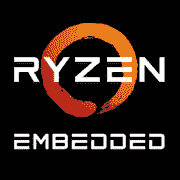AMD Ryzen Embedded 5800E

AMD Ryzen Embedded 5800E: Comprehensive Overview of a Processor for Demanding Tasks
Introduction
The AMD Ryzen Embedded 5800E is a processor designed for professional and industrial solutions. It combines the high performance of the Zen 3 architecture with the reliability needed for embedded systems. In this article, we will examine its features, compatibility, use cases, and compare it to competitors.
1. Key Specifications: Architecture and Major Advantages
Zen 3 Architecture and 7nm Process Technology
The processor is based on Zen 3 architecture (codename Vermeer) and is manufactured using TSMC's 7nm process. This offers:
- High transistor density — more performance with lower power consumption.
- Improved IPC (instructions per clock) — 19% higher than Zen 2.
- Unified L3 cache of 32 MB — reduces latency in data exchange between cores.
Performance
- 8 cores / 16 threads — suitable for multitasking and resource-intensive tasks.
- Base frequency of 3.0 GHz, maximum frequency up to 4.3 GHz (Precision Boost 2).
- TDP of 100 Watts — a balance between power and energy efficiency.
Key Features
- Support for PCIe 4.0 — 24 lanes for fast interaction with NVMe drives and GPUs.
- Extended temperature range — operates in conditions from 0°C to 95°C, which is critical for industrial systems.
- Long-term support (5+ years) — guarantees stability for embedded solutions.
Real-world Example: In surveillance systems, the 5800E processes streams from 16 cameras at 4K resolution without quality loss, thanks to the optimized cache.
2. Compatible Motherboards
Socket AM4 and Chipsets
The processor utilizes the AM4 socket but is aimed at specialized boards for the embedded segment. Supported chipsets include:
- AMD X570 — for maximum performance and PCIe 4.0.
- B550 — budget option with support for PCIe 3.0/4.0.
- Industrial chipsets (e.g., from ASUS or Gigabyte's IMB series) — with enhanced VRMs and support for ECC memory.
Selection Features:
- Presence of active cooling — due to the 100W TDP.
- ECC memory support — important for corporate tasks.
- Interfaces — at least 2 M.2 slots for NVMe and 6+ SATA ports.
Example: The ASUS ROG Crosshair VIII Impact is suitable for compact systems, but for industrial tasks, it’s better to choose the Gigabyte MW34-SP0 with ECC support.
3. Supported Memory Types
- DDR4-3200 MHz (officially), but overclocking up to 3600 MHz is possible.
- Operating modes: dual-channel.
- ECC memory — is supported, which is important for servers and data processing systems.
Recommendations:
- Optimal volume — 32 GB (2x16 GB).
- Best modules: Crucial DDR4-3200 ECC or Kingston Fury Renegade.
4. Power Supply Recommendations
- Minimum power: 500W (for a system with a discrete GPU like NVIDIA RTX 3060).
- Without GPU: 300W is sufficient (for example, Be Quiet! SFX Power 300W).
- Critical parameters:
- 80+ Gold certification — for stability.
- 20% power overhead — for peak loads.
Example: In an industrial PC with the 5800E and Quadro P1000, a Corsair CX550M power supply is used — quiet and reliable.
5. Pros and Cons of the Processor
Pros
- High multi-threaded performance.
- Support for PCIe 4.0 and ECC memory.
- Long lifespan and guarantee of updates.
Cons
- No integrated graphics — requires a discrete GPU.
- Limited overclocking — the multiplier is locked.
- Price — more expensive than desktop counterparts (e.g., Ryzen 7 5800X).
6. Use Cases
- Industrial computers: machine control, IoT devices.
- Servers: virtualization, databases.
- Media processing: 4K rendering, streaming.
- Gaming: when paired with a powerful GPU (e.g., RTX 4070).
Real Case: At the Bosch plant, the 5800E is used for real-time data analysis from sensors, replacing two older Xeon processors.
7. Comparison with Competitors
AMD Ryzen 7 5800X
- Pros of 5800E: ECC support, extended temperature range.
- Cons: more expensive and lower frequency (4.3 GHz vs. 4.7 GHz for 5800X).
Intel Xeon E-2388G
- Pros of Intel: Built-in UHD P750 graphics.
- Cons: Fewer cores (8 vs. 8), but worse multi-threading (16 threads vs. 16).
Conclusion: The 5800E excels in tasks where reliability and multi-threading are crucial.
8. Practical Assembly Tips
- Cooling: a cooler rated for TDP above 130W (Noctua NH-U12S).
- Case: proper ventilation (Fractal Design Define 7).
- BIOS: update to the latest version for compatibility.
- Testing: check stability in AIDA64 under 100% load.
9. Final Conclusion: Who Should Choose the Ryzen Embedded 5800E?
This processor is ideal for:
- Corporate clients: need for long-term support and ECC memory.
- Industrial systems: operating in extreme conditions.
- Enthusiasts: building compact powerful PCs without compromises.
Why choose it? The combination of Zen 3 performance, reliability, and specialized features makes it unique in the embedded segment. If you need a "working" processor for years, the 5800E is perfect.
We hope this overview has helped you understand the features of the AMD Ryzen Embedded 5800E. Happy building!
Basic
CPU Specifications
Memory Specifications
GPU Specifications
Share in social media
Or Link To Us
<a href="https://cputronic.com/cpu/amd-ryzen-embedded-5800e" target="_blank">AMD Ryzen Embedded 5800E</a>